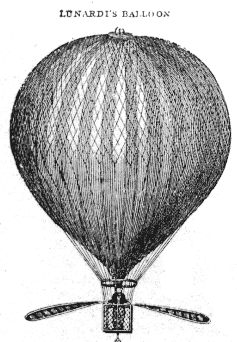English Balloons
Today, we ride the first hot-air balloons in England. The University of Houston's College of Engineering presents this series about the machines that make our civilization run, and the people whose ingenuity created them.
Dickens's A Tale of Two Cities contrasted London and Paris -- England and France. Dickens began by calling the late 18th century
the age of wisdom ... the age of foolishness
the epoch of belief ... the epoch of incredulity.
And that it was. It was an age of stimulus. Revolution was brewing in both countries -- political revolution in France, industrial revolution in England. The English middle class applied religious zeal and technical creativity to the improvement of life. At least in the beginning, the French intelligentsia attacked tyranny with a highly-honed and playful curiosity. The English, on the other hand, looked down their noses at the French balloon mania. Author L.T.C. Rolt quotes an English newspaper that called upon
all men to laugh this new folly out of practice as soon as possible.
England's first balloon flew a year after the first French ones, but the flyer, Vincent Lunardi, was a dashing, self-aggrandizing young ladies' man from the Italian embassy. He made his own monument to the flight, and wrote on it:
Let posterity know, and knowing be astonished!
That on the 15th day of September, 1784,
Vincent Lunardi of Lucca in Tuscanny,
the first aerial traveler in Britain,
mounting from the Artillery Ground in London,
and traversing the regions of the air for 2 hours and 15 minutes,
in this spot revisited the earth
One English luminary was impressed. The Duchess of Devonshire promptly had Lunardi to dine. Lunardi went on to barnstorm England. For two years he charmed the public with his showmanship. Then his unoccupied balloon got away with a young bystander's arm tangled in a rope. It carried the poor lad a hundred or so feet into the air before he came loose and fell to his death. The English press turned on Lunardi. A contemporary ballad ridiculed him:
Behold an Hero comely, tall and fair,
His only food phlogisticated air, ...
Now drooping roams about from town to Town
Collecting pence t'inflate his poor balloon.
A temporarily deflated Lunardi went back to Italy. But he was soon at it again. When his balloon landed in Spain, villagers took him for a saint and triumphantly carried him off to the local church.
The next foreign barnstormer to reach England was the French balloonist Blanchard. He had all of Lunardi's megalomania but little of his charm. The Duchess of Devonshire was again one of the few who saw opportunity. She made one of Blanchard's ascents into a huge Whig party fundraiser. Blanchard went on to make the first channel crossing and the first American ascent.
Ballooning had to be imported into England. It could never have ben born of eighteenth-century British virtues. Flight has always been the gift of less serious people -- the eighteenth-century European bourgeois -- people wiwith time to play, people with a proper respect for frivolity.
I'm John Lienhard, at the University of Houston, where we're interested in the way inventive minds work.
(Theme music)
Rolt, L.T.C., The Aeronauts: A History of Ballooning, 1783-1903. New York: Walker and Company, 1966.
Foreman, A., Georgiana: Duchess of Devonshire. New York: Random House, 1998, pg. 168.
This is a greatly revised version of Episode 118.


Vincent Lunardi and his balloon